Stalybridge, Hyde, Mossley and Dukinfield Tramways
History
The Stalybridge, Hyde, Mossley and Dukinfield Tramways and Electricity Board was jointly owned by the councils in its title, and was often referred to simply as the 'SHMD Joint Board'. The initial scheme had been intended to include Ashton-under-Lyne Corporation, however, agreement could not be reached on shared electricity generation (Ashton-under-Lyne Corporation was already an electricity producer), so Ashton-under-Lyne Corporation withdrew, eventually opening its own municipal tramway system.
Curiously, one of the councils — Hyde — had independently acquired powers to build a short line from the Oldham, Ashton and Hyde Electric Tramway Company's terminus at Gee Cross, to meet the tracks of Stockport Corporation Tramways at Pole Bank. This line was opened on the 1st of January 1903, but was immediately leased to the OA&HETCo rather than being worked by the SHMD Joint Board.
At the other end of the system, Stalybridge became a tramway owner on the 31st March 1903, when it exercised its right to purchase the Manchester Carriage and Tramway Company's horse tramway within the borough, the final legalities not being completed until 1907. As a consequence, the horse tramway service between Ashton and Stalybridge immediately ceased, which seems to have been an oversight on the part of Stalybridge, given that conversion to electric traction was obviously going to take some time. An agreement was, however, soon reached for Manchester Corporation Tramways to temporarily operate a through horse service from Ashton to Stalybridge, and this commenced on the 23rd April 1903. The horse tramway within Ashton, which ran from Audenshaw in the west through to the boundary with Stalybridge in the east was converted to electric traction by Manchester Corporation Tramways (under contract), whilst the continuation eastwards, which was within Stalybridge, was converted by the SHMD Joint Board.
The last horse tram service ran on the 14th October 1903; this was operated by the MCT, and was in fact the last horse tram service to run over former MC&TCo metals. Standard-gauge electric services commenced the next day, and though the SHMD Joint Board had agreed a joint running agreement with Ashton Corporation Tramways, the former did not actually have enough tramcars to work the service, so it was initially operated by the ACT alone.
The first SHMD Joint Board-operated electric service commenced on the 21st May 1904 over the newly constructed line from Stalybridge to Hyde via Dukinfield. The SHMD Joint Board eventually comprised just over 21 route miles, reaching out to the Roaches near Mossley in the northeast, Mottram in the southeast, and Hyde in the south. It connected with the ACT at Stamford Park on the Stalybridge-Ashton boundary and at Alma Bridge and County Bridge on the Ashton-Dukinfield Boundary, as well as with the OA&HETCo in Market Street, Hyde. These connections led to many joint services and through-running agreements, mostly between the ACT and the SHMD Joint Board, but also involving the Manchester Corporation Tramways and Stockport Corporation Tramways.
The system was, however, far from profitable, with heavy calls being made on local rate payers to make good sizeable annual shortfalls. Significant economies were instituted, but it was to take almost twenty years before the SHMD turned a profit, in 1923 to be precise.
In 1918, various local councils, including Hyde, exercised their rights to purchase those portions of the OA&HETCo within their respective municipal boundaries. Hyde Corporation formally took possession of 2.63 route miles of track (0.99 miles of which were already owned by Hyde but which had been leased to the OA&HETCo) on the 24th May 1921, though the company agreed to continue working the system until the 1st of July. The MCT took over services running via Denton to Hyde, with the SCT doing likewise for the route from Bredbury, with SHMD Joint Board cars eventually running through to Edgeley in Stockport and Victoria Street near the cathedral in Manchester.
The SHMD Joint Board introduced its first bus service on the 29th May 1925, and was to expand them significantly over the next few years, many of them being introduced in place of tram services. Six years later, in 1931, the SHMD Joint Board formally decided to abandon the tramway system, though it proved to be a long, drawn-out process. On the 15th July 1936, the name of the enterprise was formally changed — to Stalybridge, Hyde, Mossley & Dukinfield Transport & Electricity Board — to reflect the change from trams to buses, but it was to be a further nine years before the last SHMD Joint Board tramcar ran, on the 12th May 1945. Trams were, however, still operated through to Hyde by the SCT and the MCT via Bredbury and Denton, respectively. The last SCT service to Hyde ran on the 2nd March 1947, and the last MCT service on the 30th December the same year.
Uniforms
Early photographs indicate that motorman were issued with double-breasted, lancer-style tunics with five pairs of buttons (narrowing from top to bottom, and bearing the SHMDT monogram — see link), and with stand-up collars. The latter bore a one-piece, script-lettering grade badge — 'Driver' — on the bearer's right-hand side, and a small, voided SHMDT monogram badge on the left-hand side Conductors wore single-breasted jackets with five buttons, two breast pockets and epaulettes (both with button fastening), and stand-up collars. The latter bore a one-piece, script-lettering 'Guard' badge on the right-hand side, and a small SHMDT monogram badge on the left-hand side. The use of 'Guard' badges by a tramway concern was extremely rare, the only other example being nearby Manchester (and possibly the South Lancashire Tramways Company, though this is much less clear), where identical collar badges were also used. It seems more than likely that the SHMD followed Manchester's lead, using the same pattern of badges, most probably from the same supplier. The badges and buttons were almost certainly brass initially, though a change was made to nickel and some point, and possibly even to chrome, though the last change may have been after the demise of the tramway.
The tensioned-crown peaked caps bore a cap badge comprising the SHMDT monogram within an open (voided) circle; like the buttons, the badges were probably brass initially, eventually transitioned to nickel and perhaps to chrome, though the latter may have been after the demise of the tramway.
Although photographic evidence is sparse, it would appear that the basic style of the uniform remained unchanged up until the late 1930s or early 1940s. In this later period, motormen and conductors were issued with more modern double-breasted jackets with lapels; the collars, however, continued to carry the standard SHMDT monogram and script-lettering grade badges, but seemingly now on the opposite sides to earlier. At some point a round chrome cap badge was introduced that bore the 'SHMDT' monogram (in green enamel) with 'TRANSPORT BOARD' inlaid in a curved green enamel border beneath; it seems likely that the inroduction of this badge post-dates the demise of the tramway.
Motormen frequently wore long double-breasted greatcoats with five pairs of buttons and high fold-over collars; the latter do not appear to have carried any insignia.
A single surviving photograph of a SHMDT inspector, indicates that they wore typical tramway inspector garb, namely: single-breasted jackets with hidden buttons (or more likely a hook and eye affair) and stand-up collars; the latter probably carried the designation 'Inspector' in embroidered script lettering. The tensioned-crown peaked caps probably bore the grade — 'Inspector' — in embroidered script lettering on a hat band.
Women were employed during the Great War — both as conductresses and as motorwomen — to replace men lost to the armed forces; photographic evidence of them in uniform is, however ,currently lacking. During the Second World War, female staff wore single-breasted, tailored jackets with breast pockets and lapels. It is unclear what insignia or headgear were worn, though the former is likely to have been the same as those used on male uniforms.
Further reading
For more information on the SHM&DT, see: 'Stalybridge, Hyde, Mossley & Dukinfield Tramways & Electricity Board (SHMD Joint Board)' by W G S Hyde and E Ogden; Transport Publishing Company (1990).
Images
Motormen and conductors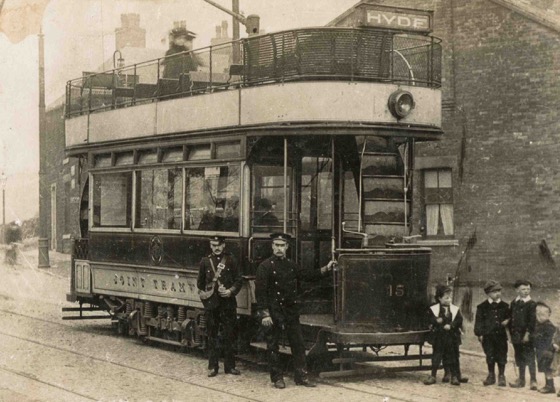
A conductor and a motorman pose with Tramcar No 15 at the Roaches Terminus with a car bound for Hyde — photo undated, but probably taken not long after the opening of the route in 1905. Author's Collection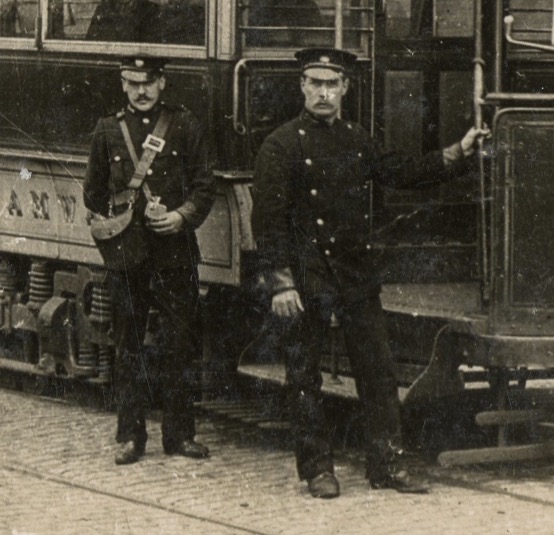
An enlargement of the above photograph showing the conductor and the motorman. Both men have grade badges on their right-hand collars — 'Driver' and 'Guard' (probably) —a practice which mirrored that of the SHMDT's close neighbour, Manchester Corporation Tramways. The cap bears a circular cap badge, and example of which is shown below.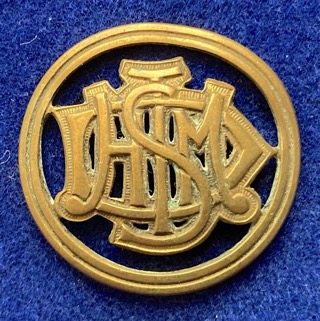
SHMDT cap badge — brass. Whilst these badges were worn throughout the tramway's life, brass was almost certainly the first material used. Author's Collection.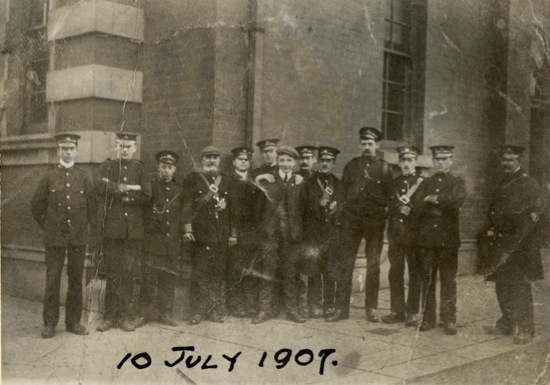
A group of tramwaymen outside the SHMDT Joint Board General Office in Waterloo Road, Stalybridge. Photo reproduced with kind permission of the Greater Manchester Transport Society (see link).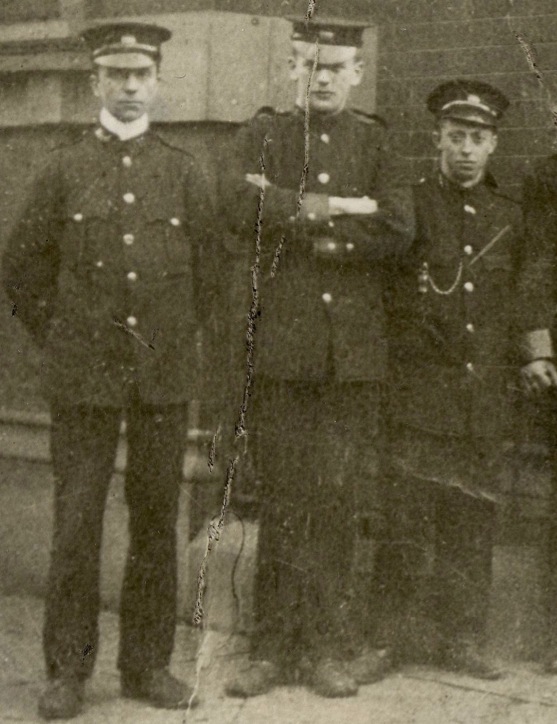
An enlargement of the above photograph showing the three men on the left. The man on the extreme left is clearly wearing a script-lettering grade badge on his right-hand collar.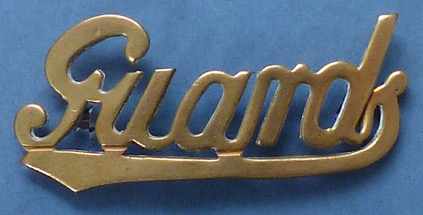
One-piece, underlined brass grade badge — 'Guard' — of the pattern used by both the SHMDT and Manchester Corporation Tramways, both as collar badges. Author's Collection.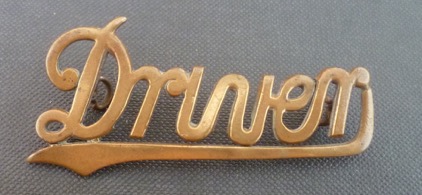
One-piece, underlined brass grade badge — 'Driver' — of the approximate type used by both the SHMDT and Manchester Corporation Tramways, both as collar badges. Author's Collection.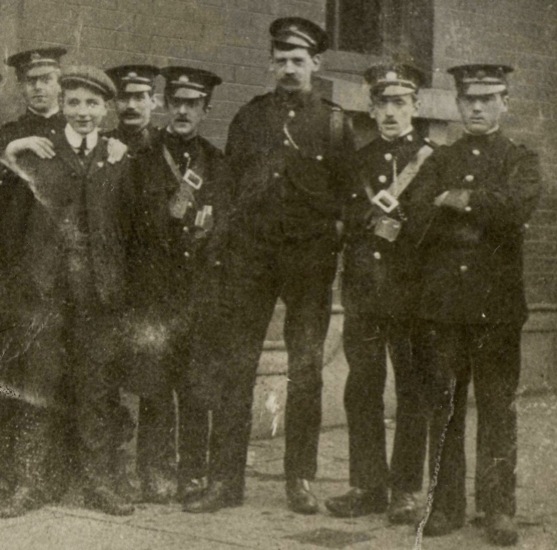
A second blow-up of the above photograph. The tall man is believed to be Albert Lewis, whilst the figure second from the right is John Willie Bray, who was later an inspector (note the badge on his left collar). The youth is believed to be Jack Whitworth, Chief Cash Clerk. Photo reproduced with the kind permission of the Greater Manchester Transport Society (see link).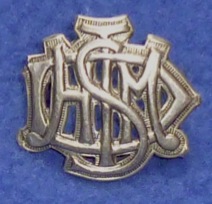
SHMDT collar badge — nickel. Whilst the initial material was almost certainly brass, at some point a change was made to nickel. Author's Collection.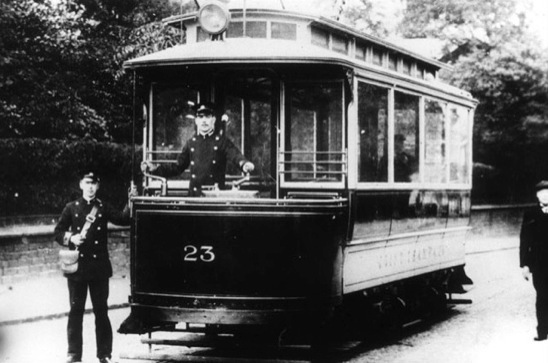
A conductor and a motorman pose with Tramcar No 23 — photo undated, but probably taken around the time of the Great War, or possibly in the early 1920s. Both men are wearing lancer-style'tunics, the motorman with his script-lettering 'Driver' badge seemingly on the wrong collar. Photo courtesy of Tameside Local Studies & Archives (see link).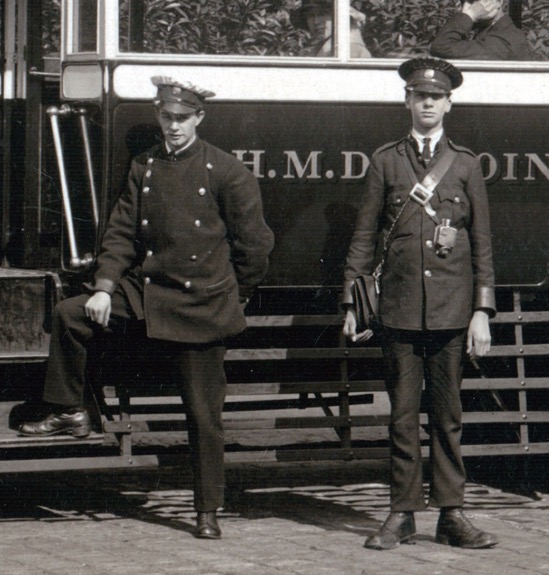
The crew of a Thornycroft BX bus (with Vickers B26D body), which was new in 1925, pose for the cameraman — photo undated, but almost certainly taken in 1925 given the pristine condition of the vehicle. Although this is a shot of a bus crew, these men almost certainly wore identical uniforms to their tramway colleagues. Photo courtesy of Karen Burns.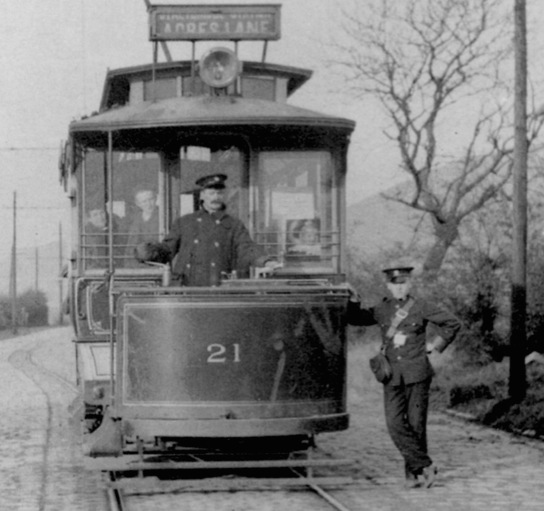
A motorman and a conductor pose with a rather battered looking Tramcar No 21 — photo undated, but given the condition of the tramcar (which had definitely been withdrawn by 1933, at the very latest) probably taken in the 1920s. Photo courtesy of the Tramways and Light Railway Society, with thanks to David Voice.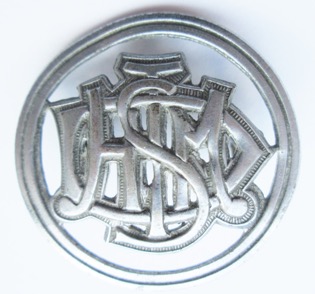
SHMDT cap badge — nickel. It is unclear when the insignia were changed from brass to nickel, but probably by the late 1920s or early 1930s. Stephen Howarth Collection.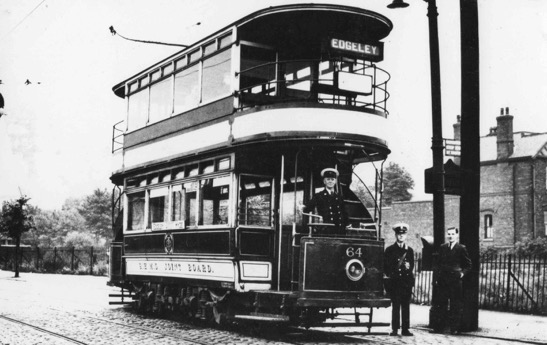
Tramcar No 64 once again, this time on a service to Stockport Edgeley — photo undated, but probably taken in the late 1930s or early 1940s. Author's Collection.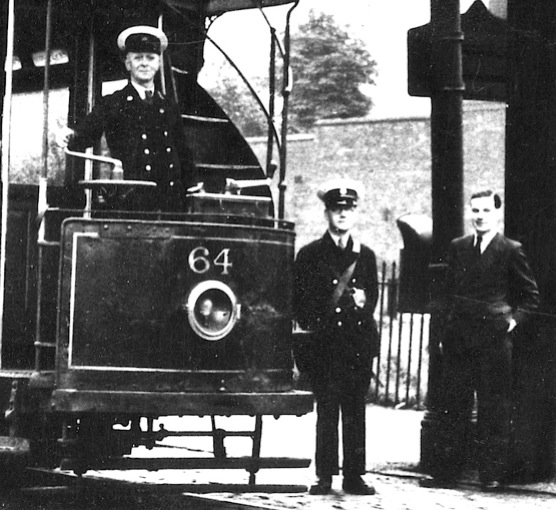
An enlargement of the above photograph showing the more modern cut of the jackets, which were double-breasted with lapels. Author's Collection.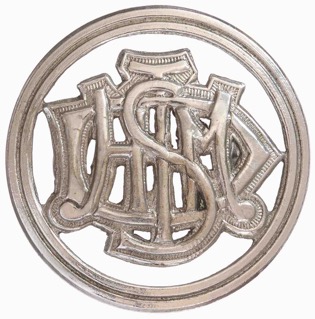
SHMDT cap badge — chrome. The uniform insignia were eventually changed to chrome, probably in the late 1930s or 1940s. Author's Collection.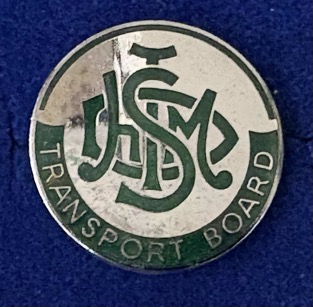
An SHM&DT cap badge — chrome and green enamel. It is unclear when this badge was introduced, but probably after the demise of the tramway in 1945.
Female staff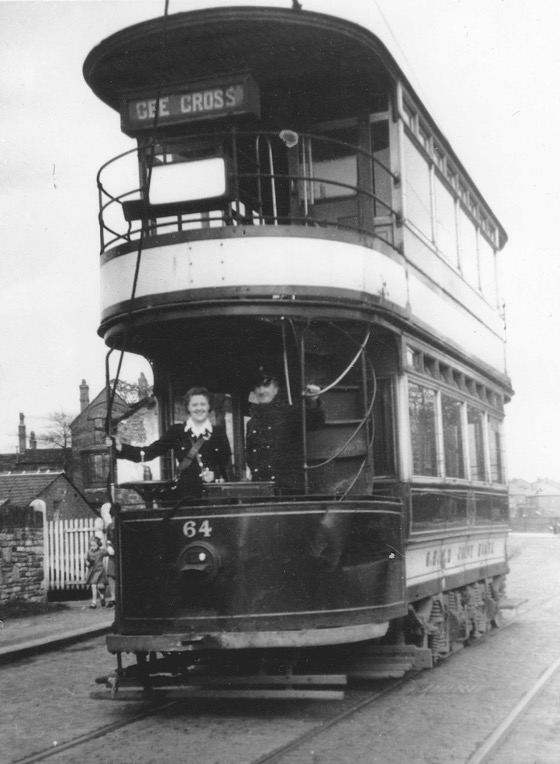
A conductress and motorman aboard Tramcar 64 on a short working from Hyde to Gee Cross — photo undated, but certainly taken during the Second World War. Photo reproduced with the kind permission of the Greater Manchester Transport Society (see link).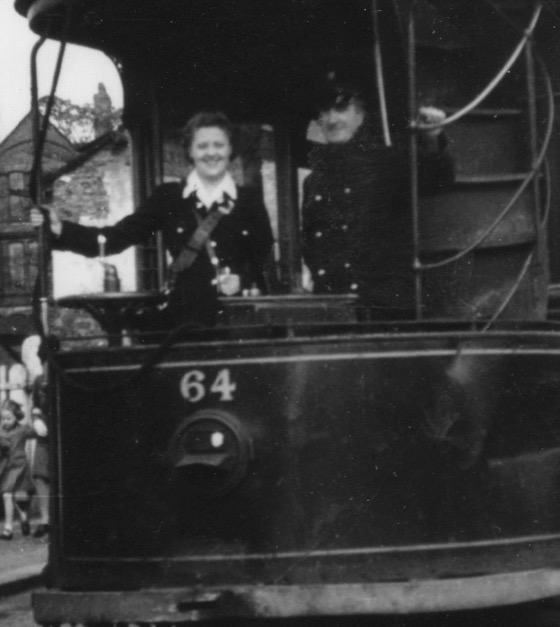
A blow-up of the above photo showing the conductress, who is wearing a single-breasted jacket with lapels.